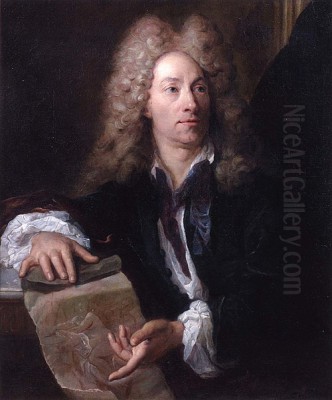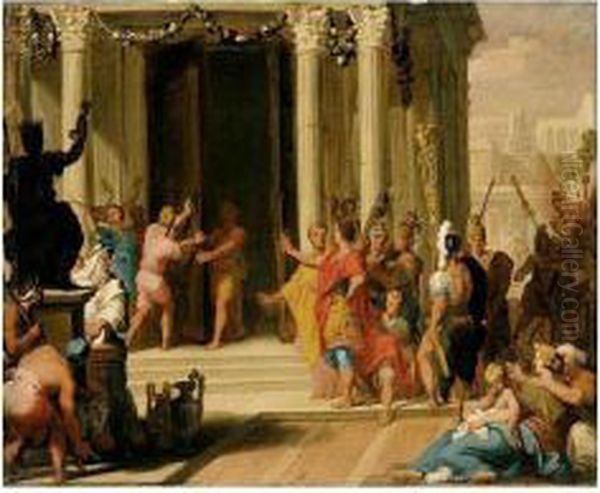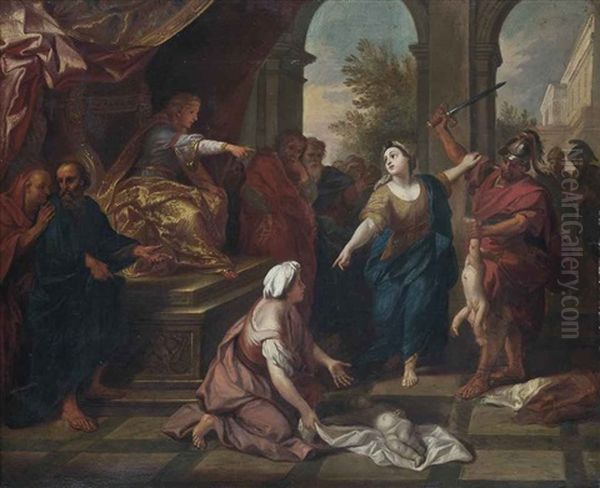
Louis de Boullogne II, often referred to as Louis de Boullogne the Younger (Louis de Boullogne le Jeune), stands as a significant figure in the landscape of French art during the late 17th and early 18th centuries. Born into an artistic dynasty in Paris on November 19, 1654, he was destined to navigate the vibrant, yet rigidly structured, art world of the Ancien Régime. His career, spanning the latter part of Louis XIV's reign, the Regency, and the early years of Louis XV, reflects both the enduring power of French Classicism and the evolving tastes of a new era. As a painter of historical, mythological, and religious subjects, a decorator of royal residences, and a pivotal director of the Académie Royale de Peinture et de Sculpture, Boullogne left an indelible mark on the artistic production and pedagogy of his time.
Artistic Lineage and Early Formation
The Boullogne family was deeply entrenched in the Parisian artistic community. Louis the Younger was the son of Louis de Boullogne the Elder (c. 1609–1674), himself a respected painter and one of the founding members of the Académie Royale. His elder brother, Bon Boullogne (1649–1717), was also a highly talented painter, creating an environment of both rich artistic learning and potential sibling rivalry. Indeed, it is recounted that their father initially hesitated to encourage Louis the Younger’s artistic pursuits, fearing competition between his sons. However, the young Louis's evident talent soon overcame these paternal concerns.
He received his foundational training from his father, absorbing the principles of drawing and composition that were the bedrock of academic art. Alongside his brother Bon, he frequented the Académie Royale, immersing himself in its rigorous curriculum, which emphasized the study of classical antiquity and the Italian Renaissance masters. This early exposure to academic discipline and the classical ideal would shape his artistic vision throughout his career. His precocious talent was recognized early; at the tender age of eighteen, around 1672, he won the prestigious Prix de Rome, a scholarship that enabled promising young artists to study in Italy at the expense of the French Crown.
The Roman Sojourn: Immersing in the Masters

In 1675 (some sources cite 1676), Louis de Boullogne the Younger embarked on his journey to Rome, the veritable mecca for aspiring history painters. The French Academy in Rome, then under the directorship of Charles Errard, provided a structured environment for French artists to study. During his five-year stay, Boullogne dedicated himself to copying the masterpieces of the High Renaissance and the leading figures of the Bolognese School.
His most significant task was the commission from Jean-Baptiste Colbert, Louis XIV's powerful Superintendent of Buildings, Arts and Manufactures, to create copies of Raphael's frescoes in the Vatican Stanze for the Gobelins Manufactory in Paris. These copies, including meticulous renditions of The School of Athens and the Disputation of the Holy Sacrament, were intended to serve as models for tapestry weavers. This intensive engagement with Raphael's monumental compositions, with their harmonious balance, idealized figures, and narrative clarity, profoundly influenced Boullogne's own approach to history painting.
Beyond Raphael, Boullogne absorbed the lessons of other Italian masters. He studied the works of Annibale Carracci and Domenichino, key figures of the Bolognese School, whose classicizing tendencies resonated with the French academic tradition. He also reportedly admired the grace and sfumato of Antonio da Correggio. This period of intense study and practice in Italy was crucial in refining his technique, expanding his visual vocabulary, and solidifying his commitment to the classical principles of order, clarity, and decorum.
Return to Paris and Academic Ascent
Louis de Boullogne returned to Paris in 1680, his skills honed and his reputation enhanced by his Roman studies. He quickly sought to establish himself within the Parisian art world, dominated by the Académie Royale. In 1681, he was received (agréé) and then accepted as a full member (reçu) of the Académie upon presentation of his reception piece, Augustus Orders the Closing of the Temple of Janus (now in the Musée des Beaux-Arts d'Amiens). This work demonstrated his mastery of classical subject matter, complex multi-figure composition, and the academic style favored by the institution.

His career progressed steadily. He received numerous commissions for religious paintings, decorating churches and chapels in Paris and beyond. Notable among these were altarpieces for the Cathedral of Notre-Dame de Paris, part of the annual "Mays de Notre-Dame" tradition, where prominent artists contributed large-scale religious paintings. His works for Notre-Dame, such as Christ and the Centurion and Christ and the Samaritan Woman, showcased his ability to convey biblical narratives with dignity and emotional resonance, adhering to the Counter-Reformation's emphasis on clear and moving religious imagery. He also contributed to the decoration of the Invalides chapel.
Mature Style and Major Royal Commissions
Boullogne's style is characterized by a strong adherence to classical principles, tempered by a certain elegance and a refined color palette that distinguished him from the more austere classicism of Nicolas Poussin, whose influence still loomed large over the Academy. His compositions are typically well-ordered and balanced, with figures often depicted in graceful, if somewhat theatrical, poses. He possessed a fine command of anatomy and drapery, and his use of color, while not as vibrant as some of his contemporaries who leaned towards Venetian influences like Charles de La Fosse, was harmonious and effective in conveying mood and highlighting narrative focus.
His talent did not go unnoticed by the Crown. He became increasingly involved in royal decorative projects, which were the most prestigious and lucrative commissions available to artists. He contributed to the extensive decorative programs at the Palace of Versailles, the ultimate symbol of Louis XIV's power and cultural ambition. He painted mythological and allegorical scenes for the royal apartments and salons, working alongside other leading artists of the day such as Antoine Coypel, Jean Jouvenet, and his own brother, Bon Boullogne. His works at Versailles include paintings in the Salon of Abundance and contributions to the Chapel Royal, designed by Jules Hardouin-Mansart.
He also worked at other royal residences, including the Château de Marly, Louis XIV's more intimate retreat. For Marly, he painted works like Summer (c. 1699), part of a series of allegories of the seasons, demonstrating his skill in adapting classical themes to decorative ensembles. Another notable mythological work is Nessus and Deianira, which showcases his ability to depict dramatic narratives with clarity and dynamism. His painting Hercules and the Cretan Bull further exemplifies his engagement with heroic mythological subjects. He also contributed to the decoration of the Grand Trianon.
The Académie Royale: Professor and Director
Louis de Boullogne the Younger was deeply committed to the Académie Royale, not just as a member but as an active participant in its governance and teaching. He rose through its ranks, becoming a professor in 1694, which involved delivering lectures and providing instruction to students. His teaching would have emphasized the foundational principles of academic art: the primacy of drawing (disegno), the study of anatomy and perspective, the imitation of classical sculpture and Renaissance masters, and the hierarchy of genres, which placed history painting at its apex.
His dedication and administrative abilities were recognized with further promotions. In 1722, he was appointed Rector of the Académie. His ascent culminated in 1725 when, following the death of Antoine Coypel, he was appointed Director of the Académie Royale de Peinture et de Sculpture. This was the most influential position within the French art establishment, giving him significant control over artistic training, exhibitions (the Salons), and the general direction of artistic taste in France. In the same year, 1725, he was also honored with the prestigious title of Premier Peintre du Roi (First Painter to the King), succeeding François Lemoyne in this role (though some sources suggest Lemoyne held it later; Boullogne's appointment in 1725 is more consistently cited for the Directorship, and the Premier Peintre title often came with it or shortly after). He was also ennobled, receiving the Order of Saint Michael, a significant mark of royal favor.
As Director, Boullogne upheld the classical traditions established by predecessors like Charles Le Brun. He sought to maintain the high standards of French art and ensure that the Académie continued to produce artists capable of undertaking major royal and religious commissions. His tenure occurred during a period of stylistic transition, with the emergence of the lighter, more intimate Rococo style, championed by artists like Jean-Antoine Watteau, François Boucher (who was a younger contemporary), and Jean-Honoré Fragonard (who came later but was a product of this evolving taste). While Boullogne himself remained a classicist, his directorship had to navigate these changing currents.
Artistic Influences, Contemporaries, and Pupils
Louis de Boullogne the Younger operated within a rich artistic milieu. His primary influence remained the classical tradition, filtered through the Italian Renaissance (Raphael) and the Bolognese School (the Carracci, Domenichino). In France, the towering figures of Nicolas Poussin and Charles Le Brun had set the standard for French Classicism. While Boullogne admired and learned from these masters, his own style possessed a softer, more graceful quality than Poussin's intellectual rigor or Le Brun's often grandiose rhetoric.
His contemporaries included a host of talented painters. His brother, Bon Boullogne, was a close artistic peer, often seen as possessing a slightly more vigorous and painterly style. Other notable history painters of his generation or slightly older included Charles de La Fosse, who introduced a greater degree of Venetian colorism and Rubénisme into French art; Jean Jouvenet, known for his powerful religious scenes; and Antoine Coypel, who, like Boullogne, held high positions in the Académie and worked extensively for the Crown. Younger contemporaries who rose to prominence during his later career included François Lemoyne, whose style showed a move towards a lighter, more Rococo sensibility, and Jean-François de Troy. Portraitists like Hyacinthe Rigaud and Nicolas de Largillière dominated their field during this period.
As a professor and director, Boullogne influenced a generation of students. Among those who passed through the Académie during his tenure and likely benefited from his guidance was Louis Galloche, who himself became a respected painter and teacher, notably instructing François Lemoyne. While Jacques-Louis David, the standard-bearer of Neoclassicism later in the century, was not his direct pupil (David was born after Boullogne's death), the academic tradition that Boullogne upheld laid the groundwork for the classical revival David would champion. Claude Simpol is also recorded as one of his pupils. He also collaborated with engravers like Bernard Picart, who translated his designs into prints, disseminating his compositions to a wider audience.
Later Career, Family, and Legacy
Even in his later years, Louis de Boullogne remained active, continuing to paint and fulfill his duties at the Académie. His long career was marked by consistent productivity and unwavering dedication to his art and to the institution that nurtured him. He married Marguerite Hérault in 1688, and they had several children. Two of his sons, Jean de Boullogne and Louis de Boullogne (sometimes referred to as Louis de Boullogne III to avoid confusion), also pursued careers, though more in finance and administration than in painting, with Jean becoming Comte de Nogent and Controller-General of Finances.
Louis de Boullogne the Younger died in Paris on November 21, 1733, just two days after his 79th birthday. He left behind a substantial body of work, including paintings, drawings, and designs for tapestries. His legacy is multifaceted. As an artist, he was a skilled practitioner of the French classical tradition, creating works of elegance, clarity, and technical proficiency. His religious paintings adorned numerous churches, and his mythological and allegorical works graced royal palaces.
In the broader history of art, his reputation has perhaps been somewhat overshadowed by his more innovative contemporaries or by the more famous figures who preceded and followed him. His brother Bon is sometimes considered the more original talent of the two. However, Louis the Younger's importance lies not only in his individual artistic achievements but also in his role as a custodian and promoter of the academic tradition. As a long-serving professor and influential Director of the Académie Royale, he played a crucial part in shaping the course of French art during a pivotal period. He helped to maintain the standards of craftsmanship and classical ideals that defined French official art for much of the 18th century.
His works can be found today in major museums, including the Louvre in Paris, the Palace of Versailles, and various regional museums in France. They serve as testaments to a dedicated artist who successfully navigated the demands of royal patronage and academic leadership, contributing significantly to the cultural splendor of his era. While perhaps not a revolutionary figure, Louis de Boullogne the Younger was an indispensable one, a pillar supporting the edifice of French art in the Grand Siècle and its transition into the Age of Enlightenment. His commitment to the classical ideal, combined with his administrative acumen, ensured the continuity and prestige of the French artistic tradition.